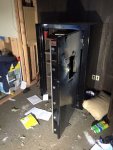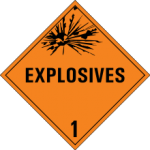Cartman- I hear what you're saying, and agree with much of it... in principal. The long and short of it is that anyone with enough time and motivation can get into anything. Given that, the goal then has to be to make it inconvenient enough for the bad guy(s) to take your stuff that they say to hell with it and head over to your neighbor's house, where hopefully (for the bad guy), things are much easier to take. I know that's a shitty thing to say, but that's the reality of it.
Realistically, most of your smash-and-grab kind of folks aren't going to have the expertise, patience, or testicular fortitude to spend all that much time trying to get into even an RSC. They may beat on it with a hammer for a few minutes, or perhaps try to pry it open, but beyond that, they're generally looking for an easy score. I recommend to people who have metalworking tools on premise that they take small, crucial bits of those tools, and put them in the safe... things like cutting torch/plasma cutter tips. Without the tips, those tools don't work worth a damn, and they (the tips) won't take up much room in the safe. For things like cut-off tools/angle grinders, it gets a bit more cumbersome to store the discs in the safe, but again, it's better than leaving them out where they can be used.
The above thoughts pertain to smash-and-grab burglars... they're unlikely to travel with their own metal cutting tools, and while they may spend a few minutes trying to let themselves into an RSC, I would guess that if they can't get it done in 10 minutes or less, they're going to take what they can and hit the road. However, if you have managed to somehow attract the attention of someone a little more... specialized... in regard to safe-breaking capability, that's where the extra security features come in handy. True, a TL-rated (or better) safe would be the ideal here... but in reality, few have the wallet (or the foundation) to support a TL-rated safe with enough storage capacity for the types of gun collections that many of us have. So, you start looking for a compromise... something that offers enough storage capacity that also offers enough security for the types of threats that we're likely to face. That second part, the likelihood of threats, is where each of us has to determine not what is possible (hell, ANYthing is possible), but what is likely. There are steps that we can all take in order to reduce the likelihood that we're going to attract attention from, shall we say, "talented", burglars.
Things like stickers... it seems like every piece of gear we buy comes with a sticker. I have a stack of them, and I'm guessing that you do, too. I don't have a single one of them on my vehicle; this is very intentional. While I'm enthusiastic about my shooting hobby, and proud of the collection of firearms and accessories that I've managed to cobble together, I don't advertise that I have any of it. Not because I don't believe in the products, but because if I don't let Joe Public know that I have those products, then Steve Burglar (Joe Public's asshole cousin) isn't likely to come looking for them. The same goes for clothing/T-shirts, though not to the same extent, IMO. Also, things like (gun) safe placement... you don't want to put it where casual visitors/workers (party attendees, plumbers, etc...) can see it, and you DAMN sure don't want it visible from the street. Ideally, it would be inside the home (as opposed to the garage), and not visible through a window. All of this speaks to "security through obscurity"; while this approach is inadequate if it is your only security measure, it is certainly viable as a layer of security. These are the sorts of things that help balance what is a realistic/likely threat against what is possible.
Once we determine what sorts of threats are likely, we then have to look at our budget, available space (within the home), storage requirements (within the safe/RSC), and, in some cases, strength of the floor (most commonly a concern in pier-and-beam homes) in order to determine the right security solution for our firearms and/or other valuables. It's certainly easy to tell people to scour Craig's list for a used TL30x6 jeweler's safe, but the reality of it is that in terms of weight (often 5k+ pounds), capacity vs. external size, and features (typically no way to run lights/dehumidifiers), that solution is less than ideal... it offers more security than is likely to be needed (for most of us), and doesn't include a number of features that border on "gotta have" (as opposed to "nice to have") status. As is the case with nearly everything in life, it's all about a balance/compromise.




